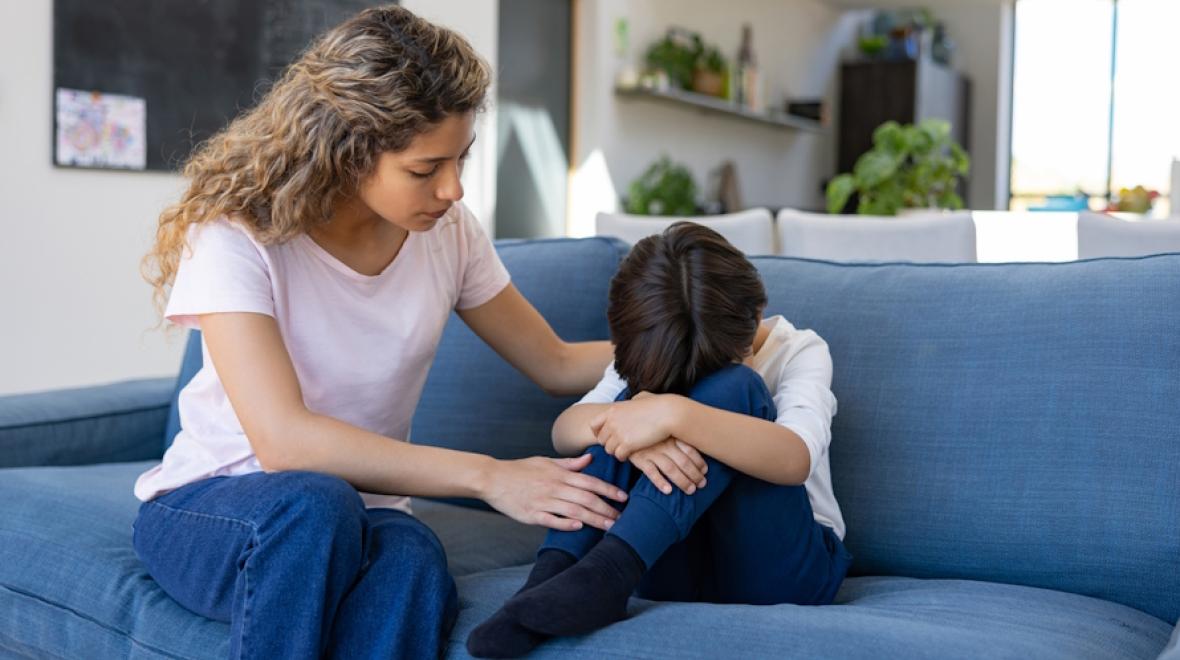
Highly sensitive children have an inborn temperament that renders them reactive to internal and external experiences. These children are called “anxious,” “difficult,” “easily distressed,” “explosive” and “highly emotional.” Parents often experience them as being rigid and inflexible. These children typically have a tough time with transitions, unfamiliar circumstances, new activities and even mild stressors. They can’t help it. So, what’s a parent to do?
Imagine a scale ― a “distress-o-meter” — which ranges from 1 to 10. What stresses the average child (situations such as feeling physically uncomfortable, being excluded or becoming frustrated with a task) and registers on the meter in the orange zone of 6 or 7 is experienced by your sensitive child as an 8, 9 or 10, which is the red zone. Your child becomes hysterical, irrational, screaming, resistant and absolutely out of control. Getting mad at a child who is in the red zone is like throwing grease on a fire. It’s better for you to remain in the cool green zone.
Routine expectations for a child (such as bedtime, going to school, participating in team sports) may seem to you like they should be mild stressors, but they can be experienced as major ones by anxious children. You might think that these things shouldn’t throw your child’s emotional throttle into the red zone, but that judgment won’t help the child learn how to calm themselves. Only lots of cognitive and emotional retraining will do so. And don’t be quick to think that this is just a therapist’s job, because if the child goes home to their most intimate, loving attachment figures (parents) and finds them angry, exasperated and judgmental, the child’s brain will be in too much of a chronic firestorm to intentionally access any coping and calming techniques.
Parents, calm yourselves
In neurological terms, when your child is having a meltdown, they are experiencing an “amygdala hijack.” The emotional part of their brain is reacting to a stressor as if it were a predator, and this triggers a “fight, flight or freeze” reaction. Parents of these children need to develop skills in calming themselves so that they can help their children learn to calm themselves, as well. In an airplane emergency, the oxygen bag needs to first go to the parent so that they can then optimally help their child.
Rational and intelligent parents can easily fall into the trap of doing all the wrong things with riled-up kids. Our tendency to provide reassurance during a red-zone moment is remarkable in how typical it is and how spectacularly it can fail to help accomplish the goals of calming the child and inspiring compliance. Whether the anxiety is triggered by a birthday party, soccer practice or homework, fear is in the mind of the beholder and is not something to be argued with during a meltdown.
Parents need to be quiet and think very carefully about what they say and transmit emotionally to their sensitive children in these moments of meltdown; they should take a page from what clinical psychologists are taught to do in emergency situations: “Don’t just do something, stand there.” In other words, first “do no harm.” A parent’s exasperated tone or an edge in their voice can take a child from a state of anxious worry to screaming hysteria.
Stress is contagious
Neuro-imaging research has documented what we’ve always known intuitively: that when one person’s brain spikes in anxiety and distress, the brain of anyone nearby activates in tandem. Kids know what their parents are feeling about them. Sensitive children can detect even mildly negative feelings, and their meltdowns can spiral downward if they sense their parents are thinking, “Oh, no, here she goes again,” “I don’t have time for this ridiculousness” or “Why can’t she be like other children?”
Yes, it’s true. Anxious children do better with Zen Buddhists as parents. But those of us who aren’t bodhisattvas should still try to achieve as calm an emotional state as possible when responding to extremely anxious children. Here are more helpful guidelines for managing in the moment:
Validate your child’s feelings
Remember that empathy doesn’t equate to agreement. During a meltdown, your child will have an elevated heart rate, seem irrational and inconsolable, and become “flooded” with stress hormones (which trigger headaches and stomachaches, for real!).
The greatest challenge for the parent in the moment is to not become dismissive, because this results in the child ratcheting up the screaming to make it clear to Mom and Dad just how upset he or she is. Instead of saying, “You love school. You’re just having a tizzy this morning,” say, “You don’t want to go to school today. Your tummy hurts, and it feels like it’s the worst day of your life.” You can paraphrase a bit to link your child’s statements with “right now” and “you feel” so that you aren’t agreeing with their dire declarations.
Stay patient and understanding about what your child is experiencing
Say to yourself: “My child doing the best she can, given her emotional state. She can’t help that she has such a sensitive temperament. She came by this temperament as innocently as other kids do asthma or diabetes.” Compassion will result in a quicker resolution to your child’s outburst, even though it will always take longer than you wish.
Listen and repeat
While you sit quietly and listen to your child, try just repeating what they are saying to you. Don’t argue. Tell them that you are listening carefully. Speak slowly and very quietly.
Anxiety is like gravity — what goes up, must come down
In other words, your child’s panic will rise, but it will always abate. The parent’s goal needs to be “damage control,” meaning not making it worse by arguing, criticizing or even talking too much, because any stimulation at all can keep your child’s emotions flooding or ramping up to another peak. Often, less is more when it comes to a parent’s response to a child’s intense emotions.
You’re not spoiling your child
Reassure yourself that this approach is not “spoiling” or “indulging” your child, but instead that it is treating the condition of high anxiety. Although it may feel to you that it takes too much time or that you are reinforcing bad behavior, remember that other punitive approaches haven’t worked.
Remember the old adage “the only person you can control is you”
Since you are probably upset that your child is upset, model your own “self-calming” by doing a breathing exercise. Breathe in slowly over five seconds and exhale slowly over the next five seconds. Use the second hand on your watch and get absorbed in taking deep belly breaths. As you become focused on your own self-calming skills, your child may decide to join in. The other advantages of an explicit focus on self-control is that you’re serving as a role model and the focus directs you away from being coercive with your child.
Consider distraction
If your child’s emotional distress is on the wane from the red zone (8–10) to the orange zone (6–7) on the distress-o-meter, distraction may help them calm down further. Perhaps you can share a childhood story about when you needed to use a technique like deep breathing or positive self-talk to calm yourself. Because shame can so easily be associated with meltdowns, your personal vignette might also convey the humble truth that everyone needs to work on self-calming sometimes.
All people benefit from this self-calming skill, also known as “emotional regulation.” It’s one of the cornerstones of emotional intelligence. I titled one of my books “Getting to Calm” because most parents of teens need to work on self-calming in order to handle the hot-button issues of adolescence.
But parents of young children with sensitive and anxious temperaments may also find that they need to become super skilled in patience and self-calming early in child-rearing. Like so many aspects of parenting, our children model, internalize and learn emotional regulation from us.
Editor's note: This article was originally published several years ago and was most recently updated in 2023.











